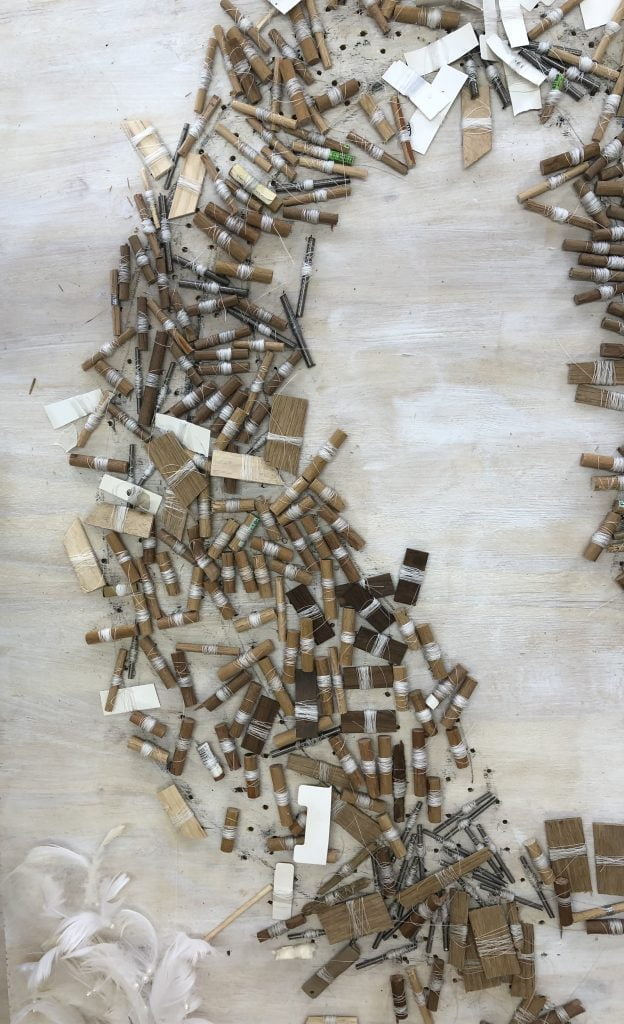FOCUSSING YOUR RESEARCH AREA
EXERCISE 2:1. Refine your ideas for research
Within my current making, it became clear that I am investigating ideas around the materiality of the cycle of life, in a personal psychological way, but also physically, in nature, in my own space, how that connects with making, whether it is about the life cycle of a feather in the feather installations, or the mycelial and fungi spore explorations. I am contemplating if I could say that soil is the hinge to which these makings and ideas are attached. I am aware of how the passing of time plays into these makings: a time to grow, a time to rest, a time to moult, a time to display (mushroom or complete bird in all its feathery plume) a time to live, a time to die, a time to grow, a time to rest, a time to learn and time to share. I also became aware of the history of the place and the consequent connections to place, not only the known political and cultural knowledge but the ones which we unsaid and unspoken about, before colonialism and the apartheid regime in my country.
The importance of documentation of my work comes to the front, and I would think this would entail the planning of a work(site), mapping of the site, evidence of work by using video footage over time and using experts (soil scientist?) and landscape designer. I have access to both experts and have explored my ideas with them. Documentation will be in writing, poetry, essays, film, and photos. The research will have some scientific data in terms of soil health and soil improvement as well as how the viewer would interact with this information and hopefully the work as a ‘transformation.’ I have decided to have a comparative study by comparing the soil from the new site to be worked on to the soil in my current veggie patch, where I have been planting and exploring organic farming (using my own homemade compost) for almost two years now. I assume chance will play a big role in the work, which could also be seen as about damage and repair, the permanent and the ephemeral. I have to accept that on the outside site, I might not be successful in growing mushrooms at the first attempt.
I have a list of artists whose work processes would influence my learning and decisions – they have collected information I can build onto. I have started a separate blog page to investigate and document thoughts and learning.
My practice is grounded in daily routines of caring, maintenance, and making. I will use small-scale models of a site and explore this with sketches/drawings to visualize the desired outcome. It could also indicate possible ‘risks’ during the making and help with planning.
My outcomes should be to show work that interacted with soil and nature and explore relationships of interconnectedness between human and non-human. Outcomes could be shown as time-based documentation accompanied by other evidence such as sculpture, installation, painting, drawings and printed works. Materials to be worked with will be mostly feathers and fungi.
I added the image below as an indicator of how I look at the research: it supports the work, it is necessary to give structure and context, It is about the resources and learning to get to a final conclusion, and it holds the work. The image below is the scoreboard of my recent feather installation. This is the drawing of the form; this is where the form emerges; this holds the form in place; this is complex and systematic; this is a form of language, like a scorecard or music score, to be read by the installer/artist/conductor/tutor, this forms a sequence, this is a work that can stand on its own, or support the final shown piece of art/making. In the end, it shows the traces, and marks made by doing the work.

Considering the parallels between learning and research:
Substitute the word learning for the word research
Researching is an active process in which the learner uses sensory input and
constructs meaning out of it. The way I explore my materials and re-use or develop more work
People research to research as they research: research consists of both constructing
meaning and constructing systems of meaning. I find meaning in my making
It’s a mind thing – I think and reflect when I research
We use language – I write about it, I talk about it.
Social aspect: In contrast, progressive education (to continue to use Dewey’s
formulation) recognizes the social aspect of learning and uses conversation,
interaction with others and the application of knowledge as an integral aspect
of learning.
Research is contextual: my work becomes active and social, it is part of my daily life, how I think, and what is important to me.
One needs the knowledge to research: in my studies, I can use previous research, the work of other artists, and philosophers, and build on it.One idea to improve the effectiveness of the writing could be to break up the text into smaller paragraphs to make it easier to read and follow the author’s thought process. Another idea could be to provide more concrete examples or anecdotes to illustrate the author’s ideas and make them more relatable to the reader. Additionally, the author could consider using more concise and precise language to make their points more clearly and efficiently.
Motivation is a key component; no it is essential to gain knowledge when I do research. It brought me to the WHY in my work.
Exercise 2.2 : Survey the current picture
Exercise 2.3: Keyword search
Exercise 2.4: Define your terms